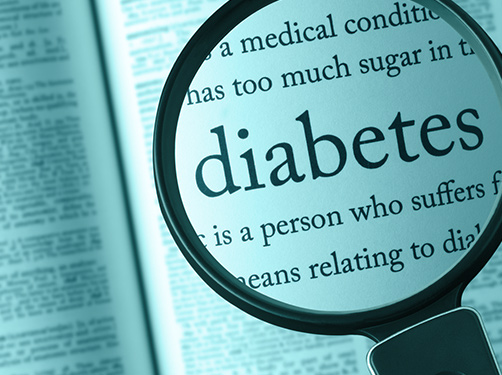Diabetes: Simply and clearly explained
Scientific support: Dr. Kálmán Bódis

Diabetes mellitus is a collective term for various metabolic disorders. What these forms of diabetes have in common is persistently high blood sugar levels. The cause: The hormone insulin is either no longer produced or not produced in sufficient quantities and/or cannot work properly on the body's cells.
The most common form is type 2 diabetes, commonly known simply as “diabetes.” Type 2 diabetes usually occurs in old age. Triggers can be lifestyle and a geneticpredisposition. This is different from type 1 diabetes. This is an incurableautoimmune disease that often occurs in childhood and adolescence.
In addition to type 1 and type 2 diabetes, gestational diabetes is widespread. There are other rarer forms of diabetes, such as MODY diabetes.
In the following sections, you will find a brief summary of the respective types and subtypes of diabetes.
Contents
1. What is diabetes mellitus?
Diabetes mellitus, commonly known simply as diabetes, is an umbrella term for various metabolic disorders. The main characteristic is a persistently elevated blood sugar level, called chronic hyperglycemia (high blood sugar).
The cause is impaired absorption of sugar (glucose) from the blood into the body's cells. To use the sugar obtained from food as an energy source for the body's cells, the body requires the hormone insulin. In people with diabetes, the effectiveness of insulin is reduced and/or the pancreas produces too little or no insulin at all. The result: Sugar remains in the blood, and the blood sugar level rises.
Essentially, a distinction is made between type 1, type 2 and gestational diabetes. Type 2 diabetes is the most common form, accounting for about 93 percent of all people with diabetes. In 2021, this amounted to approximately 8.5 million people in Germany.
| Type 1 diabetes | Type 2 diabetes |
Frequency | ||
Around 6 percent of all people with diabetes in Germany | Around 93 percent of all people with diabetes in Germany | |
Age of onset | Most often occurs in childhood and adolescence | Mostly in adults, but also children and young people |
Treatment | Lifelong insulin injections required | Initially through lifestyle changes, then medication, and possibly insulin injections |
Cause | ||
Autoimmune disease; the immune system targets insulin-producing beta cells | Diverse; often associated with lifestyle factors such as being overweight and lack of exercise |
Further information on each type of diabetes can be found in the following sections:
Did you know?
Diabetes mellitus is much more complex than the classification into type 1 and type 2 diabetes suggests. Therefore, experts propose a new classification: The classification into 5 diabetes subtypes. These are abbreviated as “SAID”, “SIDD”, “SIRD”, “MOD” and “MARD”. In order to assign patients to one of the diabetes subtypes, certain parameters are collected and analyzed. The classification into subtypes allows for estimating a mild or severe course of the disease with an individual risk of specific secondary diseases. The optimal treatment can also be derived from the respective subtype.
It is important to treat diabetes mellitus as early as possible. Depending on the type of diabetes, a lifestyle adjustment may be sufficient to lower blood sugar levels. However, taking medication or insulin injections may also be necessary.
Persistently elevated blood sugar levels can damage blood vessels, nerves, and organs. However, there are many ways to strengthen one's health and avoid so-called “long-term effects.”
More information on possible diabetes-related secondary diseases can be found in our background article.
2. What is type 1 diabetes?
Type 1 diabetesis an autoimmune disease. It usually occurs in childhood or adolescence, but adults can also develop type 1 diabetes. It is also commonly referred to as juvenile diabetes.
In type 1 diabetes, the body’s immune system mistakenly attacks the insulin-producing beta cells in the pancreas. As a result, the body can no longer produce insulin.
The lack of insulin makes it difficult for sugar to get from the blood into the body cells. As a result, blood sugar levels rise, leading to a life-threatening condition called hyperglycemia.
The signs of type 1 diabetes often develop within a few weeks or even days.
Typical symptoms of type 1 diabetes include:
- Intense feeling of thirst
- Frequent urination
- Weight loss
- Muscle weakness
- Tiredness and exhaustion
If the symptoms of type 1 diabetes are not recognized and treated, it can lead to diabetic ketoacidosis – an acute emergency that requires immediate hospital treatment.
Symptoms of ketoacidosis include the following:
- Severe nausea
- Vomiting
- Stomach pain
- Labored breathing
- Sweetish breath or urine that smells like spoiled fruit (acetone)
- Visual impairment
- Dry mouth
- Fatigue
- Lightheadedness
- Confusion
- Dry skin
- Loss of consciousness and even coma
To date, type 1 diabetes cannot be cured. People with type 1 diabetes need to monitor their blood sugar levelsand inject insulinthroughout their lives. However, modern technology now makes it possible to live an almost normal life with the disease.
Good to know:
You will find a variety of videos in the diabinfo media library.
There are also many informative and practical infographics, checklists and leaflets available in our download area.
You can find more information about the symptoms, treatment options, diagnosis and secondary diseases of type 1 diabetes as well as information about type 1 diabetes in everyday life in our background articles.
3. What is type 2 diabetes?
Type 2 diabetes typically develops after the age of 40 and is often referred to as adult-onset diabetes. People often refer to simply as “diabetes.”
In type 2 diabetes, the body's cells gradually become less responsive to the hormone insulin. Experts also refer to this as insulin resistance. Consequently, the pancreas initially increases insulin production, but over time, the excess insulin becomes insufficient to overcome insulin resistance. This leads to an increase in blood sugar levels, indicating the presence of type 2 diabetes.
Risk factors for type 2 diabetes include being overweight, an unhealthy diet as well lack of physical activity. Genetic predisposition also plays a role in its development. People who have the so-called metabolic syndrome, characterized by symptoms such as being overweight (especially in the abdominal region), high blood sugar and lipid levels, and hypertension, also increases the risk of developing type 2 diabetes.
At the onset of type 2 diabetes, weight reduction may be sufficient to improve blood sugar levels. This involves dietary changes and increased physical activity. If this basic therapy is not successful, it may be necessary to take blood sugar-lowering medications or insulin.
Type 2 diabetes often develops gradually over several years. Due to the lack of specific symptoms, diagnosis often occurs by chance. However, individuals with type 2 diabetes may experience typical symptoms of the disease when blood sugar levels are very high.
Symptoms of type 2 diabetes can include:
- Increased thirst
- Frequent urination
- Fatigue
- Feeling of weakness
- Lack of energy
- Poor performance or concentration
- Forgetfulness
- Dejection and even depression
- Visual impairment
- Frequent infections
- Poorly healing wounds
- Dry skin
You can find more information about the symptoms, treatment options, diagnosis and secondary diseases of type 2 diabetes as well as information about type 2 diabetes in everyday life in our background articles.
4. What is gestational diabetes?
Gestational diabetes is a metabolic disorder that first occurs during pregnancy.
Similar to type 2 diabetes,it involves reduced sensitivity of cells to the hormone insulin, leading to insulin resistance. Additionally, the pancreas does not produce enough insulin to compensate for insulin resistance, resulting in elevated blood sugar levels. Persistent high blood sugar levels indicate gestational diabetes.
This metabolic disorder usually resolves after childbirth. However, if not detected and treated in a timely manner, it can have short- and long-term consequences for both the child and the mother.
The symptoms of gestational diabetes, such as increased thirst or fatigue, are very non-specific and are often confused with common side effects of pregnancy. A so-called sugar test between the 24th and 28th. week of pregnancy provides information about whether the metabolic disorder is present. You can find out more about diagnosing gestational diabetes here.
In most cases, dietary adjustments and increased physical activity are sufficient to bring blood sugar levels back to normal during pregnancy. Treatment with insulin is only considered if the blood sugar levels cannot be reduced through lifestyle changes.
Women with gestational diabetes have an increased risk of developing type 2 diabetesafter giving birth. Follow-up care is therefore very important.
Further information about gestational diabetes can be found in our background articles.
5. What other forms of diabetes are there?
The most common forms of diabetes are type 1and type 2 diabetes, as well as gestational diabetes. However, there are also mixed forms and other rare types of diabetes mellitus. These can be caused by, among other things, genetic defects, infections, treatment with certain medications, disrupted hormone production or diseases of the pancreas.
In Germany, these rare forms of diabetes are referred to as “secondary forms of diabetes” or “other types of diabetes”. They were previously grouped under the term “type 3 diabetes”.
Sources:
American Diabetes Association: Diagnosis and Classification of Diabetes Mellitus. In: Diabetes Care, 2014, 37: S81-S90
Bundesärztekammer et al.: Nationale Versorgungsleitlinie Typ-2-Diabetes. Teilpublikation der Langfassung. 2. Auflage. Version 1. 2021
Danne, T. et al. (2014): Diabetes bei Kindern und Jugendlichen. 7. Auflage. Springer Verlag, Heidelberg, ISBN: 978-3-642-24645-6
Deutsche Diabetes Gesellschaft et al.: S3-Leilinie Gestationsdiabetes mellitus (GDM) - Diagnostik, Therapie und Nachsorge. Langfassung. 2. Auflage. 2018 (Gültigkeit abgelaufen, in Überarbeitung)
Deutsche Diabetes Gesellschaft et al.: S3-Leilinie Gestationsdiabetes mellitus (GDM) - Diagnostik, Therapie und Nachsorge. Patientinnenempfehlung. 2. Auflage. 2018 (Gültigkeit abgelaufen, in Überarbeitung)
Deutsche Diabetes Gesellschaft: S3-Leitlinie Therapie des Typ-1-Diabetes. 2. Auflage. 2018 (Gültigkeit abgelaufen, in Überarbeitung)
Häring, H.-U. et al. (2011): Diabetologie in Klinik und Praxis. 6. Auflage. Georg Thieme Verlag KG, ISBN: 9783135128061
Landgraf, R. et al.: Therapie des Typ-2-Diabetes. In: Diabetologie, 2022, 17: S159-S204
Nauck, M. et al.: Definition, Klassifikation und Diagnostik des Diabetes mellitus. In: Diabetologie, 2018, 13: S90-S96
Nyenwe, E. A. et al.: The evolution of diabetic ketoacidosis: An update of its etiology, pathogenesis and management. In: Metabolism, 2016, 65: 507-521
Schäfer-Graf, U. et al.: Gestationsdiabetes mellitus (GDM), Diagnostik, Therapie und Nachsorge – Kurzfassung der S3-Leitlinie. In: Diabetologie, 2021, 16: S215-S225
Zaharia, O. P. et al.: Risk of diabetes-associated diseases in subgroups of patients with recent-onset diabetes: a 5-year follow-up study. In: Lancet Diabetes Endocrinol, 2019, 7: 684-694
As of: 26.10.2023




